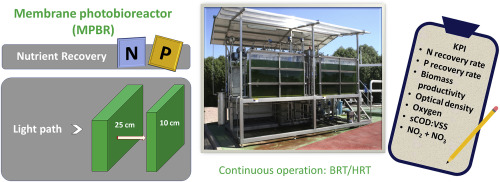Water Research ( IF 11.4 ) Pub Date : 2020-01-21 , DOI: 10.1016/j.watres.2020.115518 J. González-Camejo , S. Aparicio , A. Jiménez-Benítez , M. Pachés , M.V. Ruano , L. Borrás , R. Barat , A. Seco

|
Microalgae cultivation has been receiving increasing interest in wastewater remediation due to their ability to assimilate nutrients present in wastewater streams. In this respect, cultivating microalgae in membrane photobioreactors (MPBRs) allows decoupling the solid retention time (SRT) from the hydraulic retention time (HRT), which enables to increase the nutrient load to the photobioreactors (PBRs) while avoiding the wash out of the microalgae biomass.
The reduction of the PBR light path from 25 to 10 cm increased the nitrogen and phosphorus recovery rates, microalgae biomass productivity and photosynthetic efficiency by 150, 103, 194 and 67%, respectively. In addition, the areal biomass productivity (aBP) also increased when the light path was reduced, reflecting the better use of light in the 10-cm MPBR plant. The capital and operating operational expenditures (CAPEX and OPEX) of the 10-cm MPBR plant were also reduced by 27 and 49%, respectively.
Discharge limits were met when the 10-cm MPBR plant was operated at solids retention times (SRTs) of 3–4.5 d and hydraulic retention times (HRTs) of 1.25–1.5 d. At these SRT/HRT ranges, the process could be operated without a high fouling propensity with gross permeate flux (J20) of 15 LMH and specific gas demand (SGDp) between 16 and 20 Nm3air·m−3permeate, which highlights the potential of membrane filtration in MPBRs.
When the continuous operation of the MPBR plant was evaluated, an optical density of 680 nm (OD680) and soluble chemical oxygen demand (sCOD) were found to be good indicators of microalgae cell and algal organic matter (AOM) concentrations, while dissolved oxygen appeared to be directly related to MPBR performance. Nitrite and nitrate (NOx) concentration and the soluble chemical oxygen demand:volatile suspended solids ratio (sCOD:VSS) were used as indicators of nitrifying bacteria activity and the stress on the culture, respectively. These parameters were inversely related to nitrogen recovery rates and biomass productivity and could thus help to prevent possible culture deterioration.
中文翻译:

通过减少光路来提高膜光生物反应器的性能:工作条件和关键性能指标
由于微藻具有吸收废水中养分的能力,因此对废水修复的兴趣日益浓厚。在这方面,在膜光生物反应器(MPBR)中培养微藻可以使固体保留时间(SRT)与水力保留时间(HRT)脱钩,从而可以增加光生物反应器(PBR)的养分负荷,同时避免冲洗出水。微藻生物量。
PBR光路从25 cm减少到10 cm,分别使氮和磷的回收率,微藻生物量生产率和光合效率分别提高了150%,103%,194%和67%。此外,光路减少时,面积生物量生产力(aBP)也提高了,这反映了10厘米MPBR工厂中光的更好利用。10厘米MPBR工厂的资本和运营支出(CAPEX和OPEX)也分别减少了27%和49%。
当10厘米MPBR设备在3–4.5 d的固体保留时间(SRT)和1.25–1.5 d的水力保留时间(HRT)下运行时,可以达到排放极限。在这些SRT / HRT范围内,该工艺无需高结垢倾向即可运行,总渗透通量(J 20)为15 LMH,比气体需求量(SGD p)在16至20 Nm 3空气·m -3渗透物之间,强调了MPBR中膜过滤的潜力。
当评估MPBR工厂的连续运行时,发现680 nm(OD680)的光密度和可溶性化学需氧量(sCOD)是微藻细胞和藻类有机物(AOM)浓度的良好指标,而溶解氧却出现了与MPBR性能直接相关。亚硝酸盐和硝酸盐(NO x)浓度以及可溶性化学需氧量:挥发性悬浮固体比率(sCOD:VSS)分别用作硝化细菌活性和培养物压力的指标。这些参数与氮的回收率和生物量生产力成反比,因此可以帮助防止可能的培养物变质。










































 京公网安备 11010802027423号
京公网安备 11010802027423号